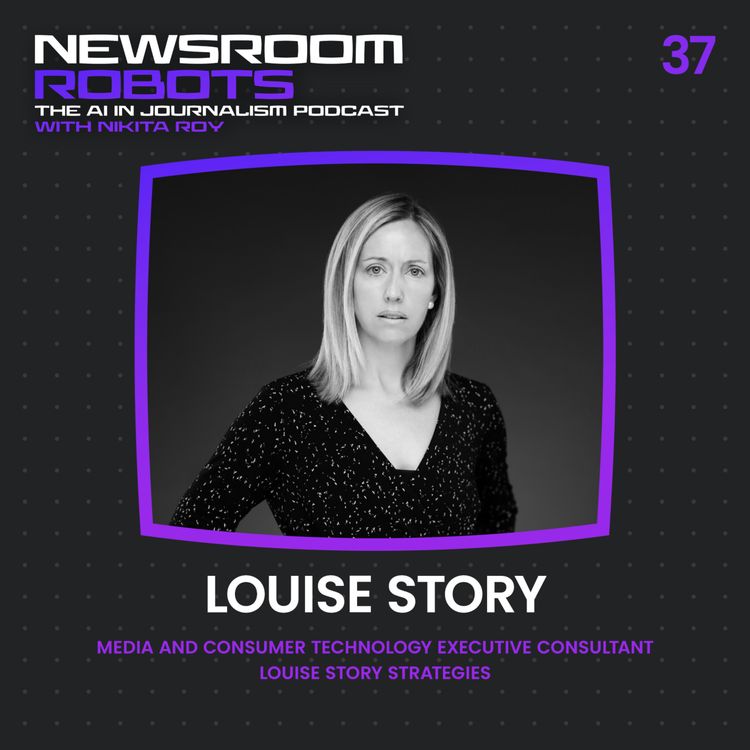Share

Newsroom Robots
Louise Story: How to Lead AI Innovation Across a News Organization
How does a newsroom leader spearhead AI innovation when AI still remains a buzzword to much of their staff?
Louise Story joins Nikita Roy to highlight the opportunities AI presents for reporting, content creation, user experience, and personalization. Story also discusses the role of journalists in the AI era and the potential impact of generative AI on the business model of the news industry.
Louise is the former Chief Technology & Product Officer and Chief News Strategist at The Wall Street Journal. She’s also been the Executive Producer & Senior Editor of Live Broadcast at The New York Times and taught at Columbia University’s Graduate School of Journalism and the Yale School of Management.
With her unique blend of journalism and technology expertise, Louise has pioneered AI innovation in one of the world’s most prestigious newsrooms. She’s the industry’s first and only individual to have worked as a senior masthead news coverage leader and a chief technology officer, and the first woman to serve as CTO at a major U.S. news organization. As a veteran journalist who drove major AI implementations at The Wall Street Journal, Louise broke down seemingly abstract concepts into an actionable vision for news companies.
Subscribe to the Newsroom Robots newsletter for insights from host, Nikita Roy.
Referenced:
🎧 Listen to the full conversation on leading AI innovation in media, available now on Apple Podcast, Spotify, and other major podcast platforms.
More episodes
View all episodes

68. Fabian Heckenberg, Naja Nielsen & Gard Steiro: The Hard Truths About AI Every Newsroom Leader Can’t Ignore (Recorded Live at Nordic AI in Media Summit 2025)
40:21||Ep. 68In this live episode of Newsroom Robots, host Nikita Roy moderates a panel discussion recorded at the Nordic AI and Media Summit in Copenhagen. The conversation features Gard Steiro (Editor-in-Chief and CEO of VG in Norway), Fabian Heckenberger (Managing Editor and Senior Editor for AI at Süddeutsche Zeitung in Germany), and Naja Nielsen (Media Director at SVT in Sweden and former Digital Director at BBC News).They discuss how news organizations are approaching the complexities of integrating AI into editorial workflows, organizational strategy, and audience experiences. The conversation focuses on the tensions, trade-offs, and open questions that newsroom leaders are wrestling with. Key topics include:How AI is shifting from isolated projects to infrastructure across newsroom operations, and the implications for leadership and cross-functional teams.Why VG uses a fixed one-year runway model to evaluate AI experiments, and what happens when projects don’t deliver measurable outcomes.The role of transparency and relevance in building trust with audiences, particularly for younger and emerging user groups.SVT’s approach to organizational learning, including how leadership can empower experimentation without centralizing all decision-making.What interdisciplinary teams look like in practice—drawing on SZ’s experience embedding editorial staff into product and tech teams.Challenges with prioritization: choosing between maintaining legacy systems, launching new GenAI tools, or refining user experience.Why personalization can’t rely on a human-in-the-loop model, and how AI agents may soon take on quality assurance roles within content pipelines.Emerging revenue considerations: from small-scale funding streams and philanthropic support to fundamental questions about what people are actually willing to pay for.The episode wraps with a candid exchange about whether the article format has outlived its usefulness in an era of personalized, multimodal news delivery and what that means for the future of storytelling and journalistic impact.Subscribe to the Newsroom Robots newsletter for more insights and updates from host Nikita Roy.
67. Gina Chua: Where Journalism’s Value Lives When AI Tells the Story
51:15||Ep. 67In this live episode, host Nikita Roy sits down with Gina Chua, Executive Editor of Semafor, recorded at an event at New York University hosted in collaboration with the AI networking group, Humans in the Loop. Gina brings a uniquely expansive lens to the AI conversation, grounded in her leadership across global newsrooms—from Reuters and The Wall Street Journal to the South China Morning Post. Now at Semafor, she continues to be a leading voice rethinking the information ecosystem for an AI-driven world.In this wide-ranging and candid conversation, Gina explores how generative AI is reshaping the fundamental architecture of journalism—from editorial workflows and business models to the core definition of a story. She discusses her team’s experiments with building custom AI tools like Miso, a multilingual aggregation system powering Semafor’s Signals format. Key topics include:How Semafor is using AI for multilingual search, editorial summarization, and style guide enforcement built directly into Google Suite workflows using App Scripts and Claude.The challenges of building durable AI products in newsrooms including unstable models, integration hurdles, and evolving use cases.Rethinking the role of journalists in an AI world: where value lies in asking the right questions, building audience understanding, and creating narratives only humans can shape.The importance of reframing journalism’s mission not as saving “journalists” or “journalism,” but as delivering information in the public interest.Behind-the-scenes on JESS (Journalist Expert Safety Support), a chatbot Gina prototyped and co-developed to democratize access to field safety guidance for reporters worldwide.Why the future of news depends on tight, authentic relationships with audiences and how startups like Semafor are designing for trust, voice, and community from the ground up.The episode closes with reflections on Gina’s personal coding journey with AI including her work building an assistive tool for a friend with ALS.Sign up for the Newsroom Robots newsletter for episode insights and updates from host Nikita Roy.
66. Zach Seward: How a Five-Person AI Team Is Powering Innovation at The New York Times
58:35||Ep. 66In this live episode, host Nikita Roy sits down with Zach Seward, Editorial Director of AI Initiatives at The New York Times, recorded at the ONA x Newsroom Robots AI Leadership Summit in Detroit. With a background that spans journalism, product, and executive leadership, Zach brings a rare blend of newsroom insight and entrepreneurial thinking to the challenges of this AI era. Before joining the Times, he co-founded Quartz, where he served as editor-in-chief, CEO, and chief product officer, helping to pioneer digital-native journalism.Now at The Times, he’s built a new editorial AI team from the ground up, experimenting with tooling, guiding newsroom adoption, and thinking through what comes next in how journalism is produced, distributed, and consumed.Key topics include:How the Times is using AI to support investigations, including analyzing hundreds of hours of leaked video and massive public data sets using custom LLM workflows.Echo, the in-house summarization tool that’s helping reporters transform articles, headlines, and tags across a range of newsroom needs.Lessons from building a five-person AI team inside a 2,000-person newsroom and why newsroom trust and individual agency are central to successful adoption.Why Zach’s team sees itself as an “AI enablement” group and how their newsroom-wide roadshow has sparked experimentation.The role of AI in reader experiences, from improving internal search to exploring voice interfaces that reimagine how audiences interact with journalism.What it means to build durable, future-ready news products in a media environment increasingly shaped by AI distribution and personalization systems.Sign up for the Newsroom Robots newsletter for episode summaries and insights from host Nikita Roy.
65. Cheryl Phillips: How AI Is Uncovering Hidden Stories in Local Government
51:01||Ep. 65When officials in Santa Clara County (home to Silicon Valley) publicly proclaimed they were not sharing data with U.S. Immigration and Customs Enforcement, they likely did not expect to be caught in a contradiction. Yet behind the scenes, those same officials had recently signed new contracts with the federal agency — a fact that might have remained hidden if not for a new generation of AI tools developed at Stanford University.This breakthrough was made possible by Big Local News, a Stanford-based initiative using AI to help local journalists uncover stories hidden deep within public records. As local newsrooms grapple with shrinking resources and overwhelming amounts of data, tools like these are helping restore investigative capacity where it’s needed most.In this episode of Newsroom Robots, Cheryl Phillips, founder and co-director of Big Local News at Stanford University, joins host Nikita Roy to share how her team is building AI-powered tools that support watchdog journalism and make complex data more accessible to reporters across the country.Key topics include:Agenda Watch, a tool that scrapes and indexes public meeting agendas to surface early signals of newsworthy developments across thousands of local agencies.DataTalk, an AI assistant that turns natural language questions into campaign finance data queries, simplifying analysis for journalists without coding expertise.The use of generative AI and large-scale scraping systems to analyze police misconduct records and create public-facing accountability databases.How Big Local News uses Slack-integrated bots to deliver real-time alerts on layoffs and problematic fiscal audits to local newsrooms across the U.S.Sign up for the Newsroom Robots newsletter for episode summaries and insights from host Nikita Roy.
64. Kasper Lindskow: Building a Scalable AI Infrastructure at Denmark's JP/Politikens Media Group
59:47||Ep. 64When it comes to AI adoption, experimentation is easy—scaling is hard. So, what is the difference between AI projects that fade out and those that transform newsrooms? A strong infrastructure.In this episode of Newsroom Robots, Kasper Lindskow, the head of AI at JP/Politikens Media Group joins host Nikita Roy. Kasper shares how as one of Denmark's largest media groups they are building a scalable AI infrastructure across multiple news brands, balancing technical innovation with editorial values.Key topics include:The Platform Intelligence in News (PIN) Project — their comprehensive research initiative that brought together technical universities and social science departmentsMagna — their flagship AI suite that adapts to each publication's unique voice and offers tools from basic writing assistance to complex research capabilitiesHow JP/Politikens evolved from a single-newsroom AI team to a centralized unit with "local AI hubs" at each publicationThe "Values Compass" framework that ensures AI systems align with journalistic integrityHow they customized AI tools for different publications and integrated them into daily newsroom workflowsSign up for the Newsroom Robots newsletter for episode summaries and insights from host Nikita Roy.
63. Rune Ytreberg and Lars Adrian Giske: How iTromsø is Building an AI-Ready Foundation for News
51:48||Ep. 63Imagine a newsroom where AI agents assist with reporting, actively surface leads, analyze government data, and help journalists navigate complex investigations in real time. Norway’s iTromsø is laying the groundwork for exactly that.In the second part of this episode with Rune Ytreberg, head of data journalism at iTromsø, and Lars Adrian Giske, head of AI join host Nikita Roy to share how their small but ambitious newsroom is systematically building an infrastructure for AI-powered journalism. This isn’t just about isolated tools—it’s about creating a cohesive ecosystem where AI enhances reporting at every level.Rather than simply bolting AI onto existing workflows, iTromsø is focused on building a structured data infrastructure that supports AI agents across multiple newsroom functions.Their vision includes:A centralized AI-powered data interface that allows journalists to filter, analyze, and cross-reference government records, public documents, and municipal archives.Automated news alerts that notify reporters when AI detects important patterns or anomalies in the data.A structured repository of historical data, ensuring journalists have context-rich information at their fingertips, allowing for deeper investigative work.This structured approach isn’t just about efficiency—it’s about creating a foundation where AI can play an active role in surfacing critical stories.iTromsø is designing an AI-ready newsroom—one where structured data, automated insights, and AI-assisted research come together to elevate investigative journalism.Sign up for the Newsroom Robots newsletter for episode summaries and insights from host Nikita Roy.
62. Rune Ytreberg & Lars Adrian Giske: Building AI Tools for Investigative Journalism in Local News
46:50||Ep. 62Translating a journalist's gut instinct into code—is it possible? In Norway, iTromsø—a long-standing regional newspaper known for its investigative journalism and deep local coverage—has found a way.Their AI system, DJINN (Data Journalism Interface for News Gathering and Notification), acts like an experienced beat reporter, scanning hundreds of municipal documents and surfacing the most newsworthy leads. The impact? In their first week using DJINN, summer interns fresh out of journalism school produced five front-page stories—on a beat that usually takes years to master.In this episode of Newsroom Robots, Rune Ytreberg and Lars Adrian Giske join host Nikita Roy to talk about iTromsø’s structured approach to AI-driven reporting and how they built tools that strengthen their local journalism.Rune leads iTromsø’s data journalism lab, where he has been developing AI-driven editorial solutions for 70 local newspapers within the Polaris Media Group since 2020. And Lars is the Head of AI at iTromsø and led the development of DJINN. Since its launch in 2023, 36 newspapers across Norway have adopted DJINN, sourcing documents from nearly half of all Norwegian municipalities.Key topics include:• How a small newsroom built AI tools to strengthen investigative journalism• Why their AI systems are designed for specific beats like urban planning and fisheries, reducing hallucinations and increasing precision.• Embedding editorial expertise in AI development• How their fisheries database flagged irregularities and how their urban planning system transformed local accountability coverage.This is just Part 1 of our deep dive into how iTromsø is using AI to power investigative reporting. In Part 2, Rune and Lars will discuss their latest project: AI-powered research assistants that will proactively surface investigative leads for their journalists.Sign up for the Newsroom Robots newsletter for episode summaries and insights from host Nikita Roy.
61. Neil Brown: The Pulitzer Prizes, AI Transparency, and Journalism’s Next Evolution
42:43||Ep. 61Neil Brown, president of The Poynter Institute and former chair of the Pulitzer Prizes, joins host Nikita Roy to discuss the Pulitzer Board's decision to require AI disclosure in prize submissions. In 2024, two Pulitzer Prize winners disclosed using AI in their work - City Bureau and Invisible Institute used machine learning to analyze police misconduct files for "Missing in Chicago," while The New York Times' visual investigations desk employed AI to identify bomb craters in Gaza. Of the 45 finalists that year, five had disclosed using AI in their submissions. In this episode, Brown discusses how the Pulitzer Board approached AI disclosure requirements and shares his perspective on technology's evolving role in journalism.Key topics include:The Pulitzer Board's approach to AI disclosure and transparencyHow newsrooms can bridge the divide between technical and editorial teamsWhy newsrooms need to take a longitudinal approach to technology adoptionThe importance of involving audiences in technological innovationLessons from journalism's digital transformation that apply to the AI eraSign up for the Newsroom Robots newsletter for episode summaries and insights from host Nikita Roy.
60. Upasna Gautam: The Product Manager's Guide to AI in News
40:00||Ep. 60Upasna Gautam, Senior Platform Product Manger at CNN and Chair of the Board of Directors at the News Product Alliance, joins host Nikita Roy to discuss her framework for AI integration in newsrooms. In this episode, Gautam breaks down her three-question approach to AI implementation and shares insights from building CNN's content management platform Stellar. Through practical examples from CNN's journey and her work with newsrooms globally, Gautam offers a systematic framework for evaluating which AI opportunities are worth pursuing.Key topics include:How CNN operates like a tech company Three essential areas for AI in news: workflow orchestration, data integration, and content modularityBuilding trust with journalists by focusing on concrete benefits over technology hypeFramework for evaluating AI opportunities that works for newsrooms of any sizeTransforming editorial teams into "mini PMs" who shape technology adoptionStrategies for successful AI implementation in resource-constrained newsroomsSign up for the Newsroom Robots newsletter for episode summaries and insights from host Nikita Roy.